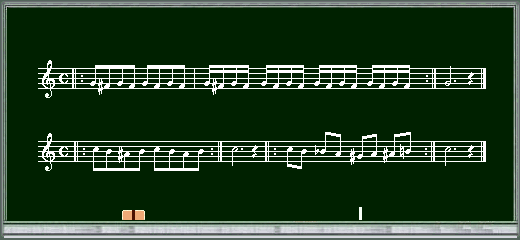If you don't explain repeatedly and in detail what students are practicing long tones for and what students should pay attention to, it will become a boring practice.
It is very important to stabilize the breath and embouchure when playing wind instruments. If students' breath and embouchure are stable, the tone and pitch will also be stable.
Pay attention to tone and make sure to include it in every practice.
In order to pay attention to tone, students must first play at a quiet volume while listening to their own sound.
If students focus on tone, they'll be concentrate so much and forget the passage of time, but for elementary school students, 2 to 3 minutes may be the limit for long tones.
So in most elementary and junior high school bands, they play scales of 4 or 8 beats each to serve as long tones. But I wonder if this is an effective practice.
Most bands I've heard play this practice too loud.
How about practicing at a tempo of 60 quarter notes, with a scale of 4 beats each (whole note scale), for a length of 4 notes (16 beats) in one breath? Start by stretching one note, then two, and gradually extend it. To do this, students will probably have to turn down the volume.
If the volume is too loud, the overall sound will make it difficult to hear each tone, and students may not notice a mistake in the sound, but in a situation where the sound is quiet, they will clearly hear the problem with the tone.
If you are going to include long tones in your rehearsal, please practice with attention to the volume. Also, instruct students who cannot sustain a long note to take a breath as slowly as possible before making a sound. There is no point in trying to breathe out.
Also, don't stop at 8 or 16 beats, but try 20 or more beats. Some elementary school students can extend their breathing by 30 beats (30 seconds). It depends on the size of the body, but the biggest issue is how deeply they can breathe.
At one junior high school, the tuba section was only practicing long tones of 8 beats, so I asked them, "What about 16 beats?" They answered, "The tuba teacher told us to practice 8 beats." I think that in any practice, you should teach "what to do at that point" as well as "if you can do this, you should practice this next time."
If students do not practice by looking at what is far away while keeping their feet firmly on the ground, they will not be able to grasp the overall picture of their instrument practice.
In the case of woodwinds, once the embouchure is stable to a minimum, I think it would be faster to start practicing scales with slurs (quarter notes and eighth notes without holding each note long) so that they can get used to the instrument more quickly.
Even with brass instruments, I think it's more fun to practice by slowly repeating notes that are semitone or one tone apart like a trill with a slur, or by playing a chromatic scale with a narrow range of about a third, strengthening the embouchure while improving the flexibility of the mouth.

Repeat the above sound shapes in one breath many times with a slur. When students can do this, speed up the tempo. Practice transposing to various pitches.
It's also important to practice melody as an application of long tones.
Practicing playing melodies individually doesn't seem to be adopted much anywhere, but I think it's the basis of music.